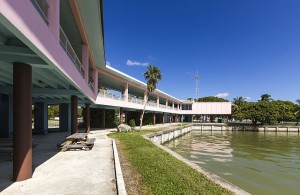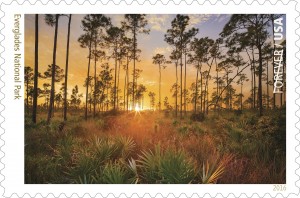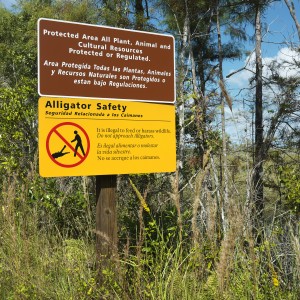 The Flamingo Visitor Center in Everglades National Park was in the running to get a much-needed renovation. The National Trust for Historic Preservation and American Express have teamed up with National Geographic to fix up historic places within national parks across the country, since the National Parks Service celebrates its 100th birthday this year.
The Flamingo Visitor Center in Everglades National Park was in the running to get a much-needed renovation. The National Trust for Historic Preservation and American Express have teamed up with National Geographic to fix up historic places within national parks across the country, since the National Parks Service celebrates its 100th birthday this year.
Along with the Flamingo Visitor Center, twenty other sites across the country were nominated to have a makeover. The public had the chance to vote which site will get funding for renovations.
After more than 1.1 million votes were cast at www.voteyourpark.org, nine preservation projects in the national park system were awarded grants. And, the Everglades won a $250,000 grant to restore the exterior of the Flamingo Visitor Center!
The Flamingo Visitor Center is 38 miles south of the Park’s main entrance, which is about an hour drive. This center has educational displays, informational brochures, a small café, and offers backcountry permits. Near the center, there are campground facilities, a public boat ramp, a marina store, and hiking and canoeing trails. The Flamingo Visitor Center was built in the 1950s as part of the Mission 66 project that was created to bring modern architecture into parks in the 1950s and 1960s. The center has a stand-out, vibrant pink façade and is built atop stilts; this center helped introduced the visitor center concept in national parks.
Many decades have passed since the center’s construction, and it is in much need of repair. Many hurricanes slammed the area and damaged the building, leaving it in not the greatest shape. If the visitor center wins the vote, it will be awarded a $250,000 grant to restore the exterior of the building.
Aside from this contest, the park does plan on revamping the center and has plans to restore the interior with a new bookstore; the park also asked for proposals for upgrades back in April that were due by July 13; the park will potentially cover up to $5 million in property investments in exchange for a 20-years concession and an annual franchise fee of nine percent for a contact that will include boat tours, kayaks, canoes, marina services, and a restaurant.
Explore the Everglades
The Flamingo Visitor Center is known as a jewel in the Everglades National Park. Despite visible wear and tear, it’s worth checking out on your trip to the area. While in the area, one of the best ways to explore all around the wetland is on an airboat. Book a trip today with Captain Mitch’s Airboat Tours. Call today at 800-368-0065 or click here to book a tour.
 The Everglades is known for many of things, and one of these things is its beauty. Now, the entire country can see this beauty every day if they want. How? A scene of the Everglades National Park will be featured on a forever stamp.
The Everglades is known for many of things, and one of these things is its beauty. Now, the entire country can see this beauty every day if they want. How? A scene of the Everglades National Park will be featured on a forever stamp. The Everglades is a beautiful, vast place that happens to be a National Park for people to experience in many different ways, year round. The “River of Grass” is full of all sorts of plant life, animal life, and landscapes; it also experiences lots of different weather. Being a park in nature, there’s a lot of unpredictable things that can happen, like bad weather, flooding, area restrictions, etc. When visiting the Everglades, it’s best to familiarize yourself with some of the park’s safety precautions and rules, so you can get the most out of your visit. Whether you’re taking an airboat tour, walking a trail, or going on a picnic, you should keep safety in mind.
The Everglades is a beautiful, vast place that happens to be a National Park for people to experience in many different ways, year round. The “River of Grass” is full of all sorts of plant life, animal life, and landscapes; it also experiences lots of different weather. Being a park in nature, there’s a lot of unpredictable things that can happen, like bad weather, flooding, area restrictions, etc. When visiting the Everglades, it’s best to familiarize yourself with some of the park’s safety precautions and rules, so you can get the most out of your visit. Whether you’re taking an airboat tour, walking a trail, or going on a picnic, you should keep safety in mind. The Burmese python is well-known to be an invasive species in the Florida Everglades; however, there seems to be another major invasive reptile in the wetland: The Nile crocodile. Yes, the Everglades are full of crocodiles, but they’re native to America. These Nile crocodiles come from Africa. But, how did these crocs make their way across the Atlantic Ocean? And, how they end up swimming around the Everglades? That is the big question.
The Burmese python is well-known to be an invasive species in the Florida Everglades; however, there seems to be another major invasive reptile in the wetland: The Nile crocodile. Yes, the Everglades are full of crocodiles, but they’re native to America. These Nile crocodiles come from Africa. But, how did these crocs make their way across the Atlantic Ocean? And, how they end up swimming around the Everglades? That is the big question.





